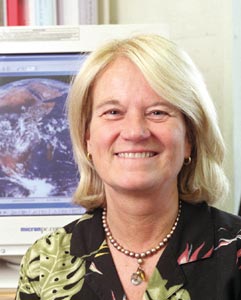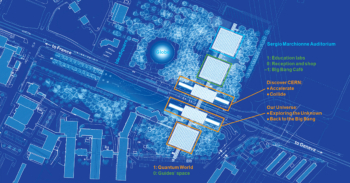It’s about time particle physics laboratories collaborated in their communication, says Judy Jackson.

Belorussian, Catalan, Taiwanese, Afrikaans, Japanese, Persian, Russian, Mandarin, Hebrew, Italian, Tagalog, Croatian, Malayalam, Serbian, German, Korean, Swedish, Cantonese, Turkish, Arabic, Romanian, Gujarati, Welsh, Georgian, Lëtzebuergesch…
These are just some of the more than 60 languages spoken by collaborators on Fermilab’s CDF and D0 experiments, as determined by a quick and utterly unscientific survey in mid-July. A poll of collaborations at CERN, DESY, KEK or any of the world’s particle physics laboratories would reveal a comparable population of polyglots – men and women from every corner of the world who have come together to explore the nature of matter and energy, space and time. Particle physics is truly one community, without borders.
Moreover, when it comes to advances in research at the world’s handful of particle physics laboratories, we are all in this together, for better or worse. When CERN gets a cold, Fermilab sneezes, and vice versa. At the moment, the particle physics world is watching as Fermilab struggles to fulfil the promise of Run II at the Tevatron; and CERN’s current LHC budget and schedule challenges have strong implications for the future of every physics laboratory. On a brighter note, a physics discovery at laboratory A inevitably builds upon work at laboratories B and C. It all comes together in one worldwide particle physics enterprise.
Yet while particle physics collaborations are international, particle physics communication is not. For the most part, each region and each laboratory communicates for itself, with little coordination on issues, strategies, resources and messages. Does a press release from one laboratory (my own, for example) trumpeting a new experimental result give more than a nod to the work at other laboratories that made the result possible? It’s doubtful. With difficult news to break, does one laboratory seek support from the others? Provide a clue that it’s coming? Not likely. In planning communication strategies, do communicators coordinate their efforts? Probably not. Global Communication Network? Forget it. When it comes to communication, every laboratory is an island.
Standard model of communication
It is high time particle physics communication caught up with the reality of particle physics collaboration. To achieve the kind of future that particle physicists everywhere would like for their field, the Standard Model of Physics Communication will have to change.
In December 2001, communicators from six of the world’s physics laboratories met at DESY in Hamburg to form a worldwide collaboration for physics communication. The immediate stimulus for the meeting was a message from Petra Folkerts, communication director at DESY, to Fermilab on 12 September 2001:
“I want to say that we are all with you in these days. I myself can’t find the right words to express my feelings after this terrible 11 September. From my point of view now it’s absolutely important that we outreach people around the world will meet as soon as possible, not only to figure out how to help international particle physics stay alive, but how we, in our field of activity, can set visible footprints for the significance of peaceful collaboration across all borders.”
The message gave impetus to a project that communicators at particle physics laboratories had pondered for some time, and led to the formation of an international laboratory communication council. Membership has grown to 10 laboratories from five countries.
Initial actions of the council include the development of a particle physics image bank comprising the best photographs and graphic resources from the world’s laboratories, appropriately captioned and credited – one-stop shopping for reporters, physicists, students, teachers and policy makers who need outstanding graphics to tell the particle physics story. The image bank will live on a new website – interactions.org – devoted not to the support of any one laboratory or region, but to all. Advance coordination of press releases among member laboratories has already begun, not only to enhance the recognition of discoveries wherever they occur, but also to foster the recognition of the interconnected nature of advances in particle physics throughout the world. The collaboration plans staff exchanges, workshops and panels at international physics conferences.
The time has passed when one laboratory or one sector of the particle physics field could profit at the expense of another. Progress at every laboratory and in every region depends on the success of particle physics everywhere. As the early American experimental physicist Benjamin Franklin told his colonial colleagues in 1776: “We must all hang together, or assuredly we shall hang separately.” The Quark Wars are over. The laboratory communication council represents a recognition of this reality by the world’s particle physics communicators. As Folkerts stressed in her message of September 2001, it is a collaborative endeavour.
Whether they speak Gujarati or Georgian, Swedish or Romanian, Tagalog or the Queen’s English, I hope that particle physicists everywhere will support this worldwide venture in physics communication.





